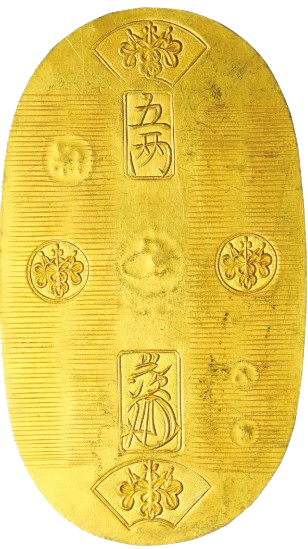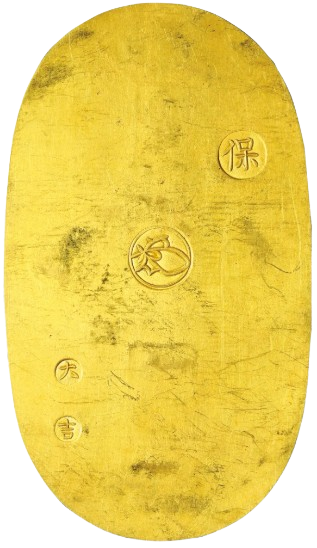Tenpō Goryō Ban Kin
(天保五両判金)


(Ginza Coins Collection, Tokyo. Reproduction authorized. © All rights reserved.)
After the cessation of minting the Kyōhō Ōban Kin coins, the Gotō Shirobei family, historically responsible for producing the prestigious Ōban coins, found itself in financial difficulty. To revive their activity, the fifteenth head of the family, Gotō Shinjō, proposed the introduction of a new gold coin worth five ryō, intended for circulation in the Kyoto market, where gold was actively traded. Although a similar proposal had previously been rejected, in 1837 Shōgun Tokugawa Ieyoshi finally authorized its issuance. According to some interpretations, the new coin may also have symbolized the beginning of Ieyoshi’s term as shōgun. However, control over the coin's production was not entrusted to the Gotō Shirobei line, but rather to the Gotō Shōzaburō family, already in charge of the Kinza mint and the production of standard gold coins. This decision was justified by the intended use of the five ryō coin, which was designed for everyday circulation, unlike the Ōban coins, which were primarily used for ceremonial purposes. The new coin, named Goryō Ban, bore the kao seal of Mitsutsugu, the same used on other official gold denominations. Production continued until 1843, when it was discovered that the combined weight of five one-ryō coins exceeded that of a single Goryō Ban, revealing a lower gold content than its face value suggested. This discrepancy undermined public trust and led to the coin’s rapid withdrawal from circulation. It is suspected that the shogunate had deliberately reduced the gold content to increase revenue, but the move backfired and damaged the coin’s credibility.
| Coin Name | Tenpō Goryō Ban Kin |
| Japanese Inscription | 天保五両判金 |
| Historical Period | Edo Period (1603-1868 d.C.) |
| Year of Minting | 1837 – 1843 d.C. |
| Chronological Reference | Japan |
| Minting Location | Edo, Kyoto |
| Issuing Authority | Clan Tokugawa (Tokugawa Tsunayoshi) |
| Function | Officially minted Valore 5 Ryō |
| Material | Gold (84.2 %) Silver (14.3 %) Other (1.5 %) |
| Shape | Oval |
| Height | 9.5 cm |
| Width | 5.4 cm |
| Weight | 33.7 g |
| Manufacturing Technique | Mold casting and manual striking |
| Obverse Text and Symbols | Gosan Kiri seal inscribed in a fan shape. Inscription Go Ryō 五両 (5 Ryō with Daiji-style numerals) Inscription Mitsutsugu 光次 and Kao Gosan Kiri seal inscribed in a circular shape |
| Reverse Text and Symbols | * Character Ho 保 indicating the era Butterfly-style Kao * * Seals Zajinin 座人印 and Dōryōin 棟梁印 (producers) |
| Calligrapher / Artist: | Gotō San’emon Mitsumichi |
| Museum References | |
| Number of Known Specimens | Very rare; only a few specimens preserved |
* A trial variant featuring, on the reverse, the character Ten 天 instead of the character Ho 保, currently held at the Currency Museum of the Bank of Japan.
** Notable seal combination: Daikichi, meaning "Great Fortune" 大吉
Sources and Bibliography
The Gold of Tokugawa, Alberto Rolfini 2025
瀧澤武雄, 貨幣 Takizawa Takeo, Kahei Nipponshi sho Hyakka 1999
